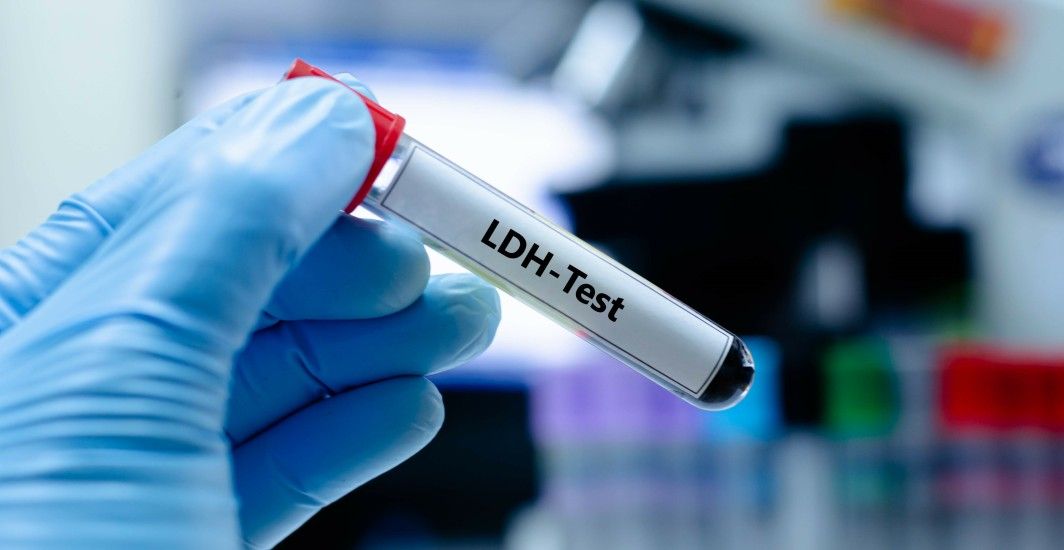General Health
LDH Test – Normal Range, Purpose, Procedure, and Results Interpretation
6 min read
By Apollo 24|7, Published on - 13 May 2025, Updated on - 14 May 2025
Share this article
0
1 like

The LDH test, or Lactate Dehydrogenase test, is a common blood test used to detect tissue damage and monitor various health conditions. LDH is an enzyme present in almost every cell of the body, including the heart, liver, kidneys, muscles, brain, and blood cells. When these cells are damaged, LDH is released into the bloodstream, making it a valuable marker for identifying tissue damage or disease.
From diagnosing acute conditions like heart attacks to monitoring chronic illnesses such as cancer or liver disease, LDH plays a critical role. This test provides vital insights into what’s happening inside the body, often before symptoms even appear. Understanding how the LDH test works, what the results mean, and when to consider it can empower patients to take charge of their health.
Purpose of the LDH Test
The LDH test is typically ordered by doctors when there is a suspicion of:
- Tissue Damage: Since LDH is released during cellular injury, elevated levels may indicate tissue damage.
- Haemolytic Anaemia: LDH helps identify the rapid breakdown of red blood cells.
- Liver and Kidney Disorders: LDH is elevated in cases of hepatitis, liver cirrhosis, or kidney disease.
- Heart Conditions: It is used as a marker to detect heart attacks and monitor heart failure.
- Certain Cancers: LDH levels may be used to stage cancer, monitor treatment response, or detect recurrence.
- Lung Diseases: It helps in evaluating pneumonia or lung injuries.
- Infections and Inflammation: LDH levels can increase in response to systemic infections or autoimmune disorders.
In essence, LDH is a versatile diagnostic marker. While it does not point to a specific disease, it signals that something in the body may require further investigation.
How to Prepare for an LDH Test?
Preparing for an LDH test is typically straightforward. However, following a few guidelines can help ensure accurate results:
- Fasting: In most cases, fasting is not required. However, if the LDH test is part of a broader metabolic panel, your doctor might ask you to fast.
- Medications: Inform your healthcare provider about any medications or supplements you are taking, as some drugs may affect LDH levels (e.g., aspirin, anaesthetics, or narcotics).
- Physical Activity: Avoid intense exercise 24 hours before the test, as muscle exertion can cause a temporary spike in LDH levels.
Alcohol: It’s best to avoid alcohol for a day or two before testing, as it can also influence results.
Always follow your doctor’s instructions for the most accurate outcome.
Procedure for LDH Test
The LDH test is a simple, quick, and minimally invasive blood test. Here’s what typically happens:
- Sample Collection: A healthcare professional will clean the skin on your arm, usually near the inside of your elbow, and draw a small amount of blood using a sterile needle.
- Duration: The entire procedure takes only a few minutes.
- Post-Test Care: You may feel a slight pinch or bruising at the puncture site, which usually resolves quickly.
In some cases, LDH levels may also be measured from other body fluids like cerebrospinal fluid (CSF) or pleural fluid, especially if your doctor suspects conditions such as meningitis or pleural effusion.
LDH Test: Results Interpretation
LDH test results are usually available within a few hours to a day. Here’s how doctors interpret the numbers:
- Elevated LDH: Suggests tissue damage but doesn’t pinpoint the exact location or cause. Additional tests are often needed to determine the underlying condition.
- Very High LDH: Often seen in severe conditions such as major organ damage, advanced cancers, or haemolysis (rapid breakdown of red blood cells).
- Low LDH: This is less common and typically not clinically significant. It may occasionally be seen in individuals taking high doses of vitamin C.
Interpreting LDH levels always depends on the clinical context. Your doctor will consider your symptoms, medical history, and possibly order further tests for a precise diagnosis.
LDH Test Normal Ranges
Lactate Dehydrogenase (LDH) is an enzyme found in many tissues, and its levels are typically measured through a blood sample known as serum LDH.
1. Serum LDH Normal Range
The serum LDH normal range in adults generally falls between 140 to 280 units per litre (U/L). However, this range may vary slightly between laboratories due to differences in testing methods and calibration. It's essential to interpret LDH levels in conjunction with your overall health condition and other lab results.
2. LDH Normal Range in Males and Females
While reference values are broadly similar, there can be minor differences in the LDH normal range for females and LDH normal range for males due to hormonal and metabolic variations:
- LDH normal range male: Approximately 135 to 285 U/L
- LDH normal range female: Approximately 135 to 275 U/L
These differences are usually subtle but may be relevant when evaluating borderline results or tracking chronic conditions over time.
If your test results fall outside the expected LDH test normal range, your healthcare provider may recommend additional investigations to pinpoint the source of tissue damage and guide the next steps in your care.
Abnormal LDH Levels
Abnormal LDH levels, whether high or low, can indicate a variety of health issues.
1. High LDH Levels May Indicate:
- Heart attack or heart failure
- Liver disease (hepatitis, cirrhosis)
- Kidney disease
- Muscle injury
- Cancers such as lymphoma, leukaemia, or metastatic disease
- Infections like sepsis or pneumonia
- Blood disorders, including anaemia and hemolysis
- Pancreatitis
- Lung conditions like pulmonary embolism
2. Low LDH Levels May Be Seen In:
Rare genetic disorders affecting LDH enzyme production
- High vitamin C intake
- Certain cancer treatments reduce LDH levels
Because LDH is found in many different tissues, its elevation alone cannot confirm a specific diagnosis. It indicates that further investigation is needed.
Managing Abnormal LDH Test Results
If your LDH levels are outside the normal range, your doctor will likely:
Correlate your symptoms and history with test results.
- Conduct Additional Tests: Imaging studies, organ-specific blood tests (e.g., liver enzymes, cardiac markers), or biopsies may follow.
- Identify Underlying Cause: LDH is just one piece of the puzzle. Once the underlying issue is found, whether it's an infection, injury, or chronic disease, your doctor will recommend a tailored treatment plan.
- Monitor Treatment: In cancer patients or those with chronic conditions, LDH can be used to track disease progression or response to treatment.
In many cases, elevated LDH is temporary and resolves once the underlying condition is treated.
Conclusion
The LDH test is a powerful diagnostic tool that offers a window into what’s happening at the cellular level in your body. Whether you’re experiencing symptoms or undergoing treatment for a known condition, this simple blood test can provide essential information about tissue health and organ function.
Early detection is key to effective treatment. If your doctor recommends an LDH test, or if you’re experiencing symptoms like fatigue, unexplained pain, or other signs of internal distress, don’t hesitate to book your test. It’s a small step that could lead to a major difference in your health journey.
General Health
Leave Comment
Recommended for you
.jpg?tr=q-80)
General Health
Complete Urine Examination – Normal Range , Purpose, Procedure and Results Interpretation
Learn about Complete Urine Examination (CUE) – its purpose, test procedure, normal ranges, and how to interpret results to detect infections, kidney issues, and more.
.jpg?tr=q-80)
General Health
Hair Fall Problem? Find Out What Tests You Should Take
Worried about hair fall? Discover the essential tests to identify the root cause of your hair loss and find effective solutions. Get clarity on your hair health today!
.jpg?tr=q-80)
General Health
Amylase Test – Normal Range, Purpose, Procedure and Results Interpretation
Learn all about the Amylase Test, including its normal range, purpose, procedure, and how to interpret your results. Understand what high or low amylase levels mean for your health.
Subscribe
Sign up for our free Health Library Daily Newsletter
Get doctor-approved health tips, news, and more.
Visual Stories

Could There Be More to Your Snore?
Tap to continue exploring
Recommended for you
.jpg?tr=q-80)
General Health
Complete Urine Examination – Normal Range , Purpose, Procedure and Results Interpretation
Learn about Complete Urine Examination (CUE) – its purpose, test procedure, normal ranges, and how to interpret results to detect infections, kidney issues, and more.
.jpg?tr=q-80)
General Health
Hair Fall Problem? Find Out What Tests You Should Take
Worried about hair fall? Discover the essential tests to identify the root cause of your hair loss and find effective solutions. Get clarity on your hair health today!
.jpg?tr=q-80)
General Health
Amylase Test – Normal Range, Purpose, Procedure and Results Interpretation
Learn all about the Amylase Test, including its normal range, purpose, procedure, and how to interpret your results. Understand what high or low amylase levels mean for your health.